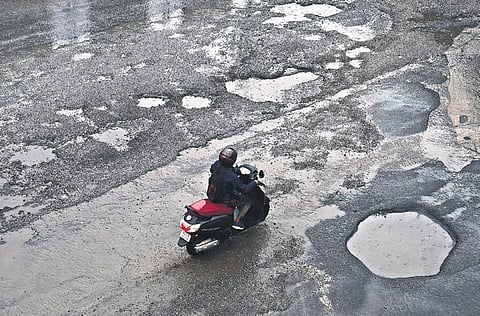

The word pothole owes its origin to Scandinavian and middle-English coinage. The lexicon defines it as “a depression or hollow in a road surface caused by wear or subsidence”. The expression in French, nid-de-poule, which literally means hen’s nest, is far more colourful. These definitions though pre-date the Indian experience.
You could say India’s potholes are a product of a warped interpretation of the Keynesian economic theory. In its essence, the theory requires governments to pay people to dig holes and then pay them to fill the holes to stimulate employment. Except in the potholes economy, there is no need to dig the holes. The potholes appear magically every year across India, whether in cities or on highways.
Typically, this year too, India’s roads are pockmarked by lunar crater sized potholes. This week the municipal corporations of two of India’s cities, Mumbai and Bengaluru and the PWD Department in Kerala were hauled up before courts. The courts were justifiably scathing in their observations, particularly Justice Devan Ramachandran of the Kerala High Court, who said, “Those stepping out should return home safely and alive, and not in a coffin.”
In the Bombay High Court, the judges criticised the delays and deterioration in roads and directed the Brihanmumbai Municipal Corporation to survey the 20 worst roads and devise a plan to repair roads. In Bengaluru, the High Court gave the BBMP a deadline of 10 days to deliver on their promise to repair the roads.
It is instructive to note that judicial intervention, while welcome, has not shaken nor stirred the system. The issue of road conditions has made repeated appearances in courts for over a decade – for example, Ashwin Shah v BMC in 2009, Rakesh Tyagi v MCD 2011, Raju Thakkar v BMC 2013, Bombay High Court On Its Own Motion vs State Of Maharashtra 2015, Roshan Jacob Oommen v State Of Kerala 2016, Mustak Hussain v State of Gujarat 2018. There have also been cases in the Supreme Court (S.Rajaseekaran vs Union of India WP 295/2012) where the apex court has directed all states to file responses. While courts have taken cognisance of the gravity of the issue, the response of governments has often been tardy, resulting in follow-up cases and claims of contempt.
The statistical reports on accidents, injuries and lives lost in road mishaps present an eloquent testimony to systemic apathy. Data available (from Ministry of Road Transport and the Supreme Court) reveals that 20,552 lives were lost between 2013 and 2020. Effectively, on an average, accidents caused by potholes claim 2500 lives every year.
Dark humour is a preferred route for folks to overcome their frustration and anger. Social media is rife with posts and memes on potholes. A resident of Kerala did photo shoots of a bride in all her finery walking the potholes ramp. A social worker in Udupi rolled on the streets as ‘urulu seva’ to protest against potholes. Mumbaikars posed with fishing rods across a pothole. Denizens in Bengaluru, India’s start-up capital, took to geo-marking potholes, for instance, Abizer’s pothole, on Google Maps.
It is not that the problem of potholes is unique to India and does afflict roads in other countries. What makes it significant in India is the scale of the problem. The magnitude is best reflected in a video shot by a reporter from Ballia in Uttar Pradesh – even as he was recording the state of roads, an e-rickshaw toppled over on camera dragging passengers under it. The very fact that posts of India’s potholes are competing with images from Kenya, Ghana, Fiji and Uganda on Twitter symbolises the state of affairs.
Such is the persistence of corruption and inefficiency that India’s cities have institutionalised annual allocations for pothole repairs. India’s commercial capital, Mumbai, for instance, spent over Rs 21,000 crore in two decades since 1998 – the budget for 2021 was over Rs 1500 crore. The allocation in the national capital Delhi was Rs 873 crore in 2020-21 and Rs 1041 crore in 2021-22. Bengaluru spent over Rs 215 crore between 2018 and 2022.
The cost to the economy is visible but yet to be computed. What could be the GDP of the pothole economy? The picture of what is actually spent for pothole repairs by cities, state public works departments, and agencies in the central government is opaque. Indeed the price being paid by the economy – from repairs to lost livelihoods to fuel consumption due to delays – merits a study by the Niti Ayog on inefficiency and wastage in the use of taxpayer monies.
There is little doubt that the political economy of potholes is expanding. And it is expanding despite the presence of elected representatives in local governments, municipal bodies and in state assemblies. For years now institutes and institutions – the IITs, the CRR-CSIR and other bodies - have examined the cause of potholes and submitted reports suggesting mitigating measures. Clearly, there are gaps in systemic checks—no doubt engineered by rent-seekers-- in the award of contracts and in oversight of execution.
The divorce of authority and accountability perpetuates third-world imagery. India is paying a heavy price in lives lost and erosion of public monies. The expectation of accountability for the use of public monies rests on questions being asked by those obliged and mandated to do so. That is not happening.
Shankkar Aiyar
Author of The Gated Republic, Aadhaar: A Biometric History of India’s 12 Digit Revolution, and Accidental India